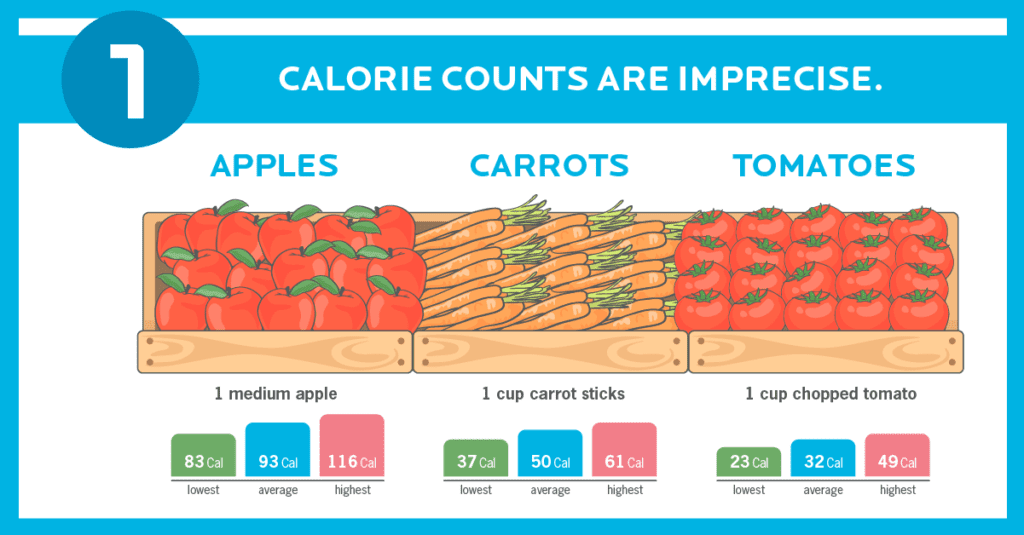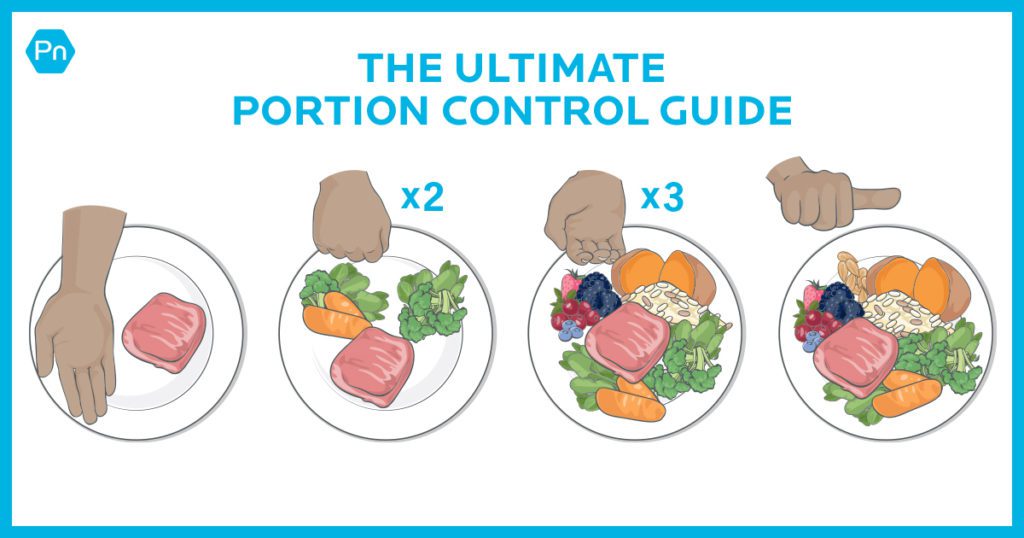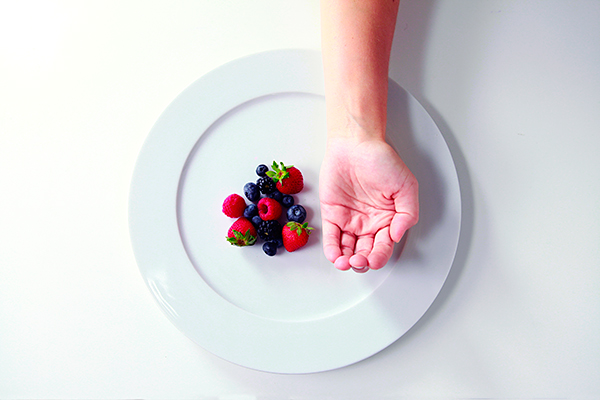Think meticulous calorie counting means knowing exactly how much breakfast you’re burning during exercise? Unfortunately, it’s more complicated than that. Here, 4 reasons why daily activity tracking and exercise counts can be problematic.
++++
We recently ran an infographic revealing some of the hidden imperfections of calorie math.
Of course, when I say “hidden”, I mean “unknown to most”. Because scientists — at least those specializing in nutrition — have known about calorie math’s quirks for a long time.
The calorie certainly has its uses, and knowing how to apply calorie counts properly is a crucial skill for health, fitness and wellness professionals (that’s why we devote a whole chapter to it in the Precision Nutrition Level 1 Certification).
However, despite what most people think, meticulous calorie counting simply isn’t a “must” when it comes to weight management — and that goes for ‘calories in’ and ‘calories out’.
In this infographic, we present 4 reasons why depending on calorie burn estimates for weight management can be really problematic.
It’ll change your understanding of how nutrition and exercise work together to achieve (or maintain) a fit, healthy body. If you’re a fitness pro, it might change how you coach and communicate with clients.
Want to download the infographic to show friends and clients? Click here for printer- and tablet-friendly versions.

Okay, we know all of this is going to blow some minds. Especially with the current fascination around calorie burn trackers and apps.
But once you’ve had some time to let it sink in, please download the infographic and spread the word.
Maybe even check out one of the following and share them too:
- The surprising problem with calorie counting. Part 1: ‘Calories in’
- Forget calorie counting: Try this simple guide for men and women
- The best calorie control guide. [Infographic]
- Can eating too little actually damage your metabolism?
Some important notes
Lowercase ‘c’
For the scientists among our readership: Throughout the introduction and infographic, ‘calories’ — lowercase ‘c’, refers to kilocalories — or ‘Calories’. Over time, popular language has lost the big C/little c distinction.
Section 1: “Calorie burn estimates are imprecise”
Direct calorimetry measures the heat you give off in a sealed metabolic chamber. It’s similar to a bomb calorimeter, which measures the caloric value of a food by burning the food, measuring the heat given off, and extrapolating the caloric value.
Doubly labeled water uses two isotopes, tritium (3H) and 18O in the form of water (3H218O). After drinking the doubly labeled water scientists sample water lost through urine, feces, and sweat, and the CO2 lost when breathing.
Using the proportions of “labeled” hydrogen and oxygen scientists can estimate energy used based on some physiological assumptions. However, some of these assumptions only hold true with minimum carbohydrate intake, so when individuals are on low-carbohydrate diets the calorie estimates are very inaccurate.
Indirect calorimetry estimates the calories you burn based on the amount of oxygen you use and carbon dioxide you produce. These values are related to overall metabolism because oxygen is consumed (and carbon dioxide given off) in proportion to metabolic activity. However, many variables affect this relationship. For example, as you consume less carbohydrate it becomes less accurate (because of basic assumptions it uses to calculate energy burned). These basic assumptions don’t hold up on a low carb diet.
Section 2: “A single variation in the FTO gene can cause you to burn 160 fewer calories per day.”
The FTO gene polymorphism has been associated with obesity. In fact, it has the most evidence supporting it and is the most compelling polymorphism for linking obesity risk to a single gene.
Section 2: “External factors affect how genes are expressed.”
Epigenetic changes result in modifications to DNA that don’t change the DNA sequence. The two main types of epigenetic modifications are DNA methylation and histone modification.
In the case of the mice referenced in this infographic, mothers ate more of the methyl donors: folic acid, B12, choline chloride, and anhydrous betaine. And their offspring were more metabolically active.
The details of epigenetics in people are less clear. However, recently, researchers found possible epigenetic causes for differences seen in body weights of identical twins.
For example: A gene called Trim28 controls a network of other genes (Nnat, Peg3, Cdkn1c and Plagl1) by epigenetic modifications (histone deacetylation). Lower levels of Trim28 lead to one twin being obese while their sibling (who has higher levels of Trim28) is lean.
Section 2: “Women’s menstrual cycle affects their resting metabolic rate.”
Although scientists aren’t 100% sure of this, hormone-driven temperature changes during the menstrual cycle are likely the reason behind the fluctuations in resting metabolic rate in women throughout menses.
Section 3: “What and how much you eat influences how many calories you’ll burn.”
The thermic effect of feeding (TEF, also called thermic effect of food, specific dynamic action, and/or dietary-induced thermogenesis) is the energetic cost of digesting, absorbing and assimilating food.
This includes the energy it takes to chew food; for enzymes to molecularly dismantle your food; and for transporters to shuttle the nutrients across your intestinal lining.
Sections 3 and 4: Adaptive thermogenesis
While adaptive thermogenesis doesn’t occur in everyone all the time, it’s a very important factor when trying to determine ‘calories out’.
In one study conducted at the Mayo Clinic, researchers overfed 16 normal-weight subjects by 1,000 calories per day for 8 weeks. That’s the equivalent of about 2 double cheeseburgers a day. And the participants were asked not to perform purposeful exercise.
Result: While this rate of overeating “should” have produced about a 16-pound weight gain in each subject, participants actually gained very different amounts of weight. The range was quite surprising: The individual with the highest adaptive metabolism gained only 0.79 pounds while the one with the lowest adaptive metabolism gained 9.3 pounds.
Why the difference? The subjects’ measured resting metabolic rate, thermic effect of food, and physical activity didn’t change much. (Although we know these measures can be somewhat error-prone). However, there were huge differences in measured non-exercise activity thermogenesis, or NEAT.
On average, NEAT went up by 336 calories per day. But from person to person, changes in NEAT ranged from -98 to +692 calories per day. (Yes, that’s a minus sign on 98. As in one poor woman actually had less NEAT.)
The changes in their NEAT output directly predicted the amount of fat each individual gained:
- More NEAT, less fat gained.
- Less NEAT, more fat gained.
This study is supported by other research, which shows:
- Some people find it easy to gain weight, and hard to lose it. Their energy expenditure (especially NEAT) doesn’t go up much when they over-eat, and they also expend much less energy when they eat less (as their NEAT drops more dramatically). They are also likely to be naturally more sedentary.
- Other people find it hard to gain weight, and easy to lose it. Their bodies adapt to over-eating by firing up the metabolic furnace (cranking up their NEAT output), and don’t slow things down as much when eating less (NEAT doesn’t drop much). This is your classic “hardgainer” who struggles to gain mass. They are also likely to be natural fidgeters.
In many people, the body fights hard to defend against weight loss or gain. However, it is usually one or the other, not both. For more, see: Can eating too little actually damage your metabolism? Exploring the truths and fallacies of ‘metabolic damage’.
Overall, researchers calculate that changes in NEAT account for 85-90% of adaptive thermogenesis.
References
Click here to view the information sources referenced in this article.
If you’re a coach, or you want to be…
You can help people build sustainable nutrition and lifestyle habits that will significantly improve their physical and mental health—while you make a great living doing what you love. We'll show you how.
If you’d like to learn more, consider the PN Level 1 Nutrition Coaching Certification.



Share